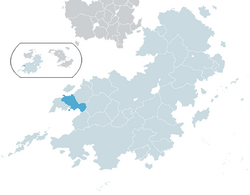Tamisari Socialist Republic
This article is incomplete because it is pending further input from participants, or it is a work-in-progress by one author. Please comment on this article's talk page to share your input, comments and questions. Note: To contribute to this article, you may need to seek help from the author(s) of this page. |
Minkathala మినాథాల | |
|---|---|
Union State | |
| Union State of Minkathala మినాథాల | |
 Location of Minkathala (dark blue) in Arthadesh (blue) | |
| Sovereign state | Arthadesh |
| Government | Autonomous parliamentary dependency |
• President | Nirad Giri |
| Legislature | State Council |
| Area | |
• Total | 5,770.24 km2 (2,227.90 sq mi) |
• Water (%) | 2.1% |
| Population | |
• 2020 estimate | 8,091,367 |
| GDP (nominal) | 2020 estimate estimate |
• Total | $80.75 billion |
• Per capita | $9,981 |
| Gini (2020 estimate) | 41.3 medium |
| HDI (2020) | 0.77 high |
Minkathala (Tamisari: మినాథాల, Gaullican: Mincathale), officially the Union State of Minkathala (Tamisari: మినాథాల యూనియన్ స్టేట్, Gaullican: État de l'Union de Mincathale), is a de jure sovereign island city-state in Satria. Since 1984, the entirety of Minkathala's internationally recognised territory has been under occupation by Arthadesh, which recognises Minkathala as an associated territory. Minkathala has a population of 8,091,367, making it the smallest state in Satria and one of the smallest in Coius.
First inhabited by Purvan peoples in the neolithic era, Minkathala was not reached by the Sattaro-Euclean expansion. A centre of Purvan, in particular Tamisari culture, Minkathala is one of the oldest continual polities in the world, with a Minkathalan state or entity existing in some form since its first attestation within the Sattarayana in roughly 1400 BCE. During the Mahakusumita, a flourishing of many different religious and philosophic traditions within Satria, Minkathala was the centre of the Ajñana movement which championed skepticism and materialism. MEDIEVAL STUFF PAGING SATRIAN REWORK BEEP BOOP. Minkathala's important location within the Bay of Bashurat led to a rising amount of Euclean influence and an eventual annexation by Gaullica. Under Gaullican rule, Minkathala soon became one of the most wealthy trading ports in Satria and was regarded as the gate to Satria. During the Great War, Minkathala served as a base of operations for Gaullican forces against Etruria in modern-day Arthadesh, but was taken in the earlier stages of the war. Following the war, Minkathala was briefly possessed by Etruria before gaining independence after the Solarian War. While Minkathala would participate in the First Satrian War on the side of Arthadesh, it soon sought neutrality in the conflicts and established itself as a democratic state. Key negotiations, such as the 1958 Minkathala Accords between Arthadesh and the Indigenous Self-Determination Army, were held on the island, which became a haven for political exiles from both sides of the Satrian Wars. However, this political openness bred polarisation and by the 1970s the state was fractured into a Pan-Satrian left led by the Satrian Section of the Worker's Internationale which favoured joining the Union of Federal Republics of Satria and a nationalist wing backed by Arthadesh. In 1984, following the surprise electoral victory of Indumat Ayyagari and the SSWI who promised a union referendum, Arthadeshi forces invaded Minkathala, claiming that Ajahadya had rigged the election. A provisional military government was installed, followed by a puppet civilian administration which signed a treaty of association with Arthadesh.
Since this treaty, the status of Minkathala has been disputed. Most nations still recognise it as an independent nation, under the de facto occupation of Arthadesh. However, given political opposition to the Rongzhou Strategic Protocol Organisation from much of the northern world, the Minkathalan issue is often ignored. Minkathala is a well off state, and a key centre of tourism in Satria. It maintains its own domestic political system, which is nominally democratic whilst still restricted as in Arthadesh.